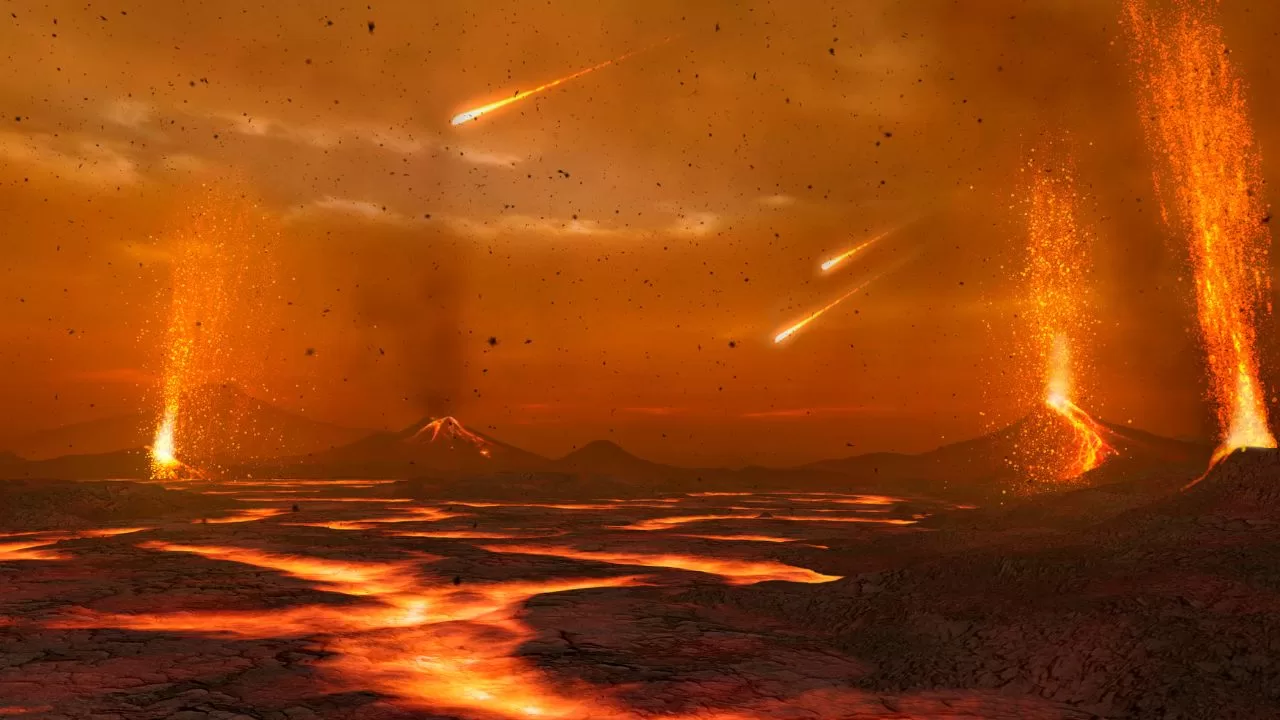- First Signs of Life: Primordial Earth
- Keywords
- Key Takeaways
- Frequently Asked Questions (FAQs)
- How did the early Earth transition from a toxic environment to one that supports life?
- What is the significance of underwater volcanic vents in the origin of life?
- How did the first cells manage to survive in the harsh early Earth conditions?
- Why is photosynthesis important in the history of life on Earth?
- Were there any other gases produced by early life?
- How did life evolve from single-celled to multi-celled organisms?
- What challenges did the rise of oxygen pose for early life?
- How did amino acids form on the early Earth?
- Why are prokaryotes considered simpler than eukaryotes?
- How do scientists study these ancient life forms and their environment?
- Myth Buster
- Myth: Life on early Earth started due to a single lightning strike.
- Myth: Oxygen has always been good for life.
- Myth: Early Earth was a calm and serene place.
- Myth: The first organisms were complex and multicellular.
- Myth: Photosynthesis is unique to plants.
- Myth: All early life forms thrived in the oxygen-rich environment.
- Myth: Primordial soup is just a theory without much evidence.
- Myth: Life could only originate in warm, shallow waters.
- Myth: All early life forms were similar in structure and function.
- Myth: Oxygen’s rise was a gradual, smooth process.
First Signs of Life: Primordial Earth
In the great tapestry of time, there was an era so remote, so ancient, that even our planet Earth might’ve needed a moment to recall. This was a time before selfies, before dinosaurs, and yes, even before weekend brunches. A time when Earth was still finding its footing (not that it has feet, but you catch the drift) in the vast cosmic playground.
Our story begins on an Earth that might seem alien to us. No blue oceans, no fluffy clouds, no trees whispering secrets to the winds. Instead, picture a world veiled in a cloak of thick, toxic gases, with landscapes reminiscent of a heavy metal band’s album cover – molten lava, meteor bombardments, and temperatures that would make even the Sahara look like a winter retreat.
Yet, amidst this chaotic symphony of geological tantrums, in the vast ancient oceans, magic was stirring. No, not the wand-waving kind, but something far more profound. The first whispers of life were preparing to utter their initial syllables.
Now, imagine being the first life form on Earth. It’s not easy, is it? You don’t have older siblings to guide you or history books to learn from. You’re basically the ultimate pioneer, trying to figure out how to ‘life’ when there’s no precedent. And let’s be honest, these earliest life forms weren’t exactly rocket scientists. They were microscopic, single-celled organisms, probably feeling a bit out of their depth. But, give them credit, they were tenacious little things.
In the warm, mineral-rich waters near underwater volcanic vents, molecules began to dance. These weren’t any ordinary jigs or waltzes; these were the dances of complex chemistry. Amino acids, the building blocks of life, started forming chains, sort of like conga lines, giving rise to proteins. These proteins, being the social butterflies they are, began to interact with other molecules, leading to the creation of the first simple cells.
We often imagine the first life forms as something dramatic, perhaps a bolt of lightning striking a primordial soup, akin to a scene from a Hollywood movie. In reality, it was more of a slow, meticulous process, much like perfecting a recipe. And boy, was Mother Nature patient with her concoction!
These first cells, called prokaryotes, lacked a defined nucleus and were rather simple in their structure. But don’t let their simplicity fool you. They had grand ambitions. Over time, some of them evolved the ability to perform photosynthesis, turning sunlight into energy. And in this process, they started producing a waste product that would change the world – oxygen. To them, it was just trash, but to future life forms, it was the elixir of life!
However, not every cell was on board with this whole oxygen production thing. For many, this new gas was toxic. It’s almost as if someone had suddenly introduced a brand new food into everyone’s diet and expected them to like it. So, while some cells thrived in this changing environment, others had to either adapt or, unfortunately, perish.
As eons passed, the game of life got more intricate. Cells began to cooperate and formed colonies. They diversified into countless forms, each trying to carve its niche in the primordial soup. Earth was no longer a desolate, lifeless rock; it now had its first inhabitants, each narrating its own silent story.
Yet, this was just the prologue. These initial life forms set the stage for the magnificent drama of evolution that would unfold over the next billions of years. From the depths of ancient oceans to the vast stretches of terra firma, life would experiment, innovate, and diversify in ways that would boggle the mind.
But let’s pause and give a standing ovation to those brave first cells. They didn’t have manuals or guides. They simply ‘lived’, driven by the primal urge to exist and thrive. And in doing so, they paved the way for every living creature that has ever graced this planet – from the mightiest of dinosaurs to, well, us. Theirs is a tale of resilience, ingenuity, and the indomitable spirit of life. And to think it all started with a little molecular dance in the vast ancient waters. Now, isn’t that something to marvel at?
Keywords
- Primordial Earth: The ancient, early version of our planet before it took on the characteristics we recognize today.
- Toxic gases: Harmful gases that can be damaging or lethal to living organisms.
- Molecular dance: The interactions and bonding between molecules leading to the formation of complex structures or substances.
- Amino acids: Organic compounds that combine to form proteins and are fundamental to the structure and function of life.
- Prokaryotes: Single-celled organisms that lack a distinct nucleus.
- Photosynthesis: The process by which green plants and certain other organisms transform light energy into chemical energy.
- Oxygen: A chemical element that is a crucial component for the respiration of most terrestrial life forms.
- Proteins: Large molecules essential for the structure, function, and regulation of the body’s cells, tissues, and organs.
- Underwater volcanic vents: Openings on the seafloor out of which heated mineral-rich water flows.
- Evolution: The process by which different kinds of living organisms develop and diversify from earlier forms.
Key Takeaways
- Earth’s ancient environment was vastly different, with toxic gases and extreme temperatures.
- The first signs of life began in the mineral-rich waters near underwater volcanic vents.
- Amino acids formed the foundation for life by creating proteins.
- The first life forms were simple cells called prokaryotes.
- Some prokaryotes developed the ability to perform photosynthesis, leading to the production of oxygen.
- The rise of oxygen led to significant evolutionary pressures.
- Cooperation and diversification among cells increased over time.
- These early life forms set the stage for the evolution of more complex organisms.
- Life’s beginning on Earth is a testament to resilience and adaptability.
- The simplest forms of life paved the way for the vast biodiversity we see today.
Frequently Asked Questions (FAQs)
How did the early Earth transition from a toxic environment to one that supports life?
Over billions of years, various processes, including volcanic activity and the action of early life forms, contributed to the transformation of Earth’s atmosphere. For instance, certain microbes started producing oxygen through photosynthesis, which gradually made the atmosphere more hospitable for advanced life forms.
What is the significance of underwater volcanic vents in the origin of life?
These vents provided the necessary heat and mineral-rich waters, creating an environment where complex chemistry could take place, leading to the first building blocks of life.
How did the first cells manage to survive in the harsh early Earth conditions?
The first cells were incredibly resilient and could withstand extreme conditions. Over time, they evolved mechanisms to harness available resources efficiently and adapt to their surroundings.
Why is photosynthesis important in the history of life on Earth?
Photosynthesis transformed Earth’s atmosphere by producing oxygen, a gas essential for the evolution and survival of most complex life forms that followed.
Were there any other gases produced by early life?
Yes, early life also produced gases like methane and helped in the nitrogen cycle. The mix of gases produced played a role in shaping Earth’s early atmosphere.
How did life evolve from single-celled to multi-celled organisms?
Over time, single-celled organisms began to cooperate, forming colonies. As these cellular communities grew, differentiation of functions occurred, leading to the first multicellular organisms.
What challenges did the rise of oxygen pose for early life?
For many early life forms, oxygen was toxic. Its rise led to what’s termed the ‘Oxygen Catastrophe’, which caused a significant die-off of anaerobic organisms. Life had to adapt or perish.
How did amino acids form on the early Earth?
There are multiple theories, but one popular belief is that amino acids formed in “primordial soup” conditions, with energy from lightning and volcanic activity driving their synthesis.
Why are prokaryotes considered simpler than eukaryotes?
Prokaryotes lack a distinct nucleus and certain organelles present in eukaryotic cells, making them structurally simpler.
How do scientists study these ancient life forms and their environment?
Scientists use a combination of fossil records, geological evidence, and advanced analytical techniques to piece together the story of early life on Earth.
Myth Buster
Myth: Life on early Earth started due to a single lightning strike.
Reality: While the “primordial soup” theory suggests that lightning might’ve played a role, the origin of life is a complex process that took millions of years and multiple factors.
Myth: Oxygen has always been good for life.
Reality: Oxygen was initially toxic to many ancient life forms and led to a significant die-off known as the ‘Oxygen Catastrophe’.
Myth: Early Earth was a calm and serene place.
Reality: Early Earth was tumultuous with constant volcanic activity, meteor bombardments, and extreme temperatures.
Myth: The first organisms were complex and multicellular.
Reality: The first life forms were simple, single-celled prokaryotes.
Myth: Photosynthesis is unique to plants.
Reality: The earliest photosynthesizers were microbial life forms, not plants.
Myth: All early life forms thrived in the oxygen-rich environment.
Reality: The rise of oxygen created a challenging environment, forcing many organisms to adapt or go extinct.
Myth: Primordial soup is just a theory without much evidence.
Reality: While the exact conditions and mechanisms remain a topic of research, there’s considerable evidence pointing to the existence of a “soup” of organic molecules on early Earth.
Myth: Life could only originate in warm, shallow waters.
Reality: Life’s origins are linked to various environments, including deep-sea hydrothermal vents.
Myth: All early life forms were similar in structure and function.
Reality: Even in its early stages, life on Earth was diverse, with organisms having varied metabolic and survival strategies.
Myth: Oxygen’s rise was a gradual, smooth process.
Reality: The introduction of oxygen into the atmosphere was a tumultuous event, with periods of rapid increase followed by stabilization.











0 Comments